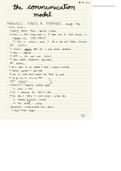TABLE OF CONTENT
• LECTURE 1 ✅
• LECTURE 2 ✅
• LECTURE 3 ✅
• LECTURE 4 ✅
• LECTURE 5 ✅
• LECTURE 6 ✅
• LECTURE 7 ✅
• LECTURE 8 ✅
• LECTURE 9 ✅
• LECTURE 10 ✅
LECTURE 1
What is a brand?
- IdenIficaIon
- DifferenIaIon
- Mental Construct
- RelaIonship Partner
- Driving force
• Brand = IdenIficaIon
o A name, term, symbol, design, sign, or any combinaIon used to idenIfy the
goods of one seller or groups of sellers.
• Brand = DifferenIaIon
o A disInguishing name or symbol intended to idenIfy the goods or services of
one seller, and to differenIate those goods and services from those of the
compeItors.
• Brand = mental construct
o Brands are mental containers of meaning and serve as internal informaIon
sources for buyers.
o Brands are networks of associaIons.
• Brand = relaIonship partner
o Brands can and do serve as viable relaIonship partners and consumer brand
relaIonships are valid at the level of lived experience.
• Brand = driving force
o [B]rands are the mechanism that connects organizaIons and people… they are
also the cultural forms that allow us to express who we are … [and] the soul of
corporaIons, organizaIons and movements.
,How to build a strong brand
Customer Based Brand Equity (CBBE) Pyramid
4 QuesIons (consumers ask about your brand):
1. Who are you? (idenIty)
2. What are you? (meaning)
3. How do I think & feel about you?
4. What is our relaIonship?
• Layer 1: Brand Salience
o Before anything else, you need to create brand salience (=the brand must
come to mind easily)
o This means you have to build brand awareness = the ability to recall and
recognize the brand (in relaIon to the needs it saIsfies).
Two types of brand awareness: recall vs recogniIon
• Recall: the brands come to mind spontaneously aka “top of mind awareness”
• RecogniIon: the brand is recognized by relevant cues (name, logo, design, packaging)
• Depth: How easily do you recall/recognize the brand?
• Breadth: In which situaIons does the brand come to mind?
General Ips for building awareness:
- More exposure is beker (low involvement learning is based on repeated exposures), so
budget is key, but also:
- Be consistent (think 10 Imes before changing logo/name/packaging)
- Always establish a link to product need
- Ensure sufficient exposure to the package (two second rule) for recogniIon
- Create a personal connecIon (use a presenter who establishes this)
o George Clooney with Nespresso/ The HEMA voice
- Use mnemonic devices (music, sound, imagery)
o I’m lovin it from McDonald’s
, • Layer 2: Brand Meaning
o Brand meaning: the associaIons with a brand, built by: own experience,
experience of others (WOM) & adverIsing
o Good associaIons:
§ Favorable
§ Strong link to the brand
§ Unique (disInct from other brands in the category)
Two types of associaIons:
1. FuncIonal, performance-related
2. Imagery-related (onen more abstract)
Brand meaning I – Brand Performance
1. Primary characterisIcs & secondary features (low sugar, high engine power)
2. Product reliability (consistency), durability, serviceability
3. Service effecIveness (level of saIsfacIon), efficiency (speedy & responsive) &
empathy (trusIng, caring)
4. Style & design (Apple)
5. Price (Aldi/Lid)l
Brand Meaning II – Brand Imagery
1. User profile: what kind of people use the brand?
2. Purchase & usage situaIon: when do you buy/use the brand
3. Personality & values
4. History, heritage & experience (both shared and individual) Douwe Egberts
• Layer 3: Consumer Judgments & Consumer Feelings
o How do consumers think & feel about the brand?
o Judgments:
§ Quality
§ Credibility (=trustworthiness, experIse, likability)
§ ConsideraIon (would I buy this brand?)
§ Superiority (beker than the others?)
o Feelings:
§ Warmth, fun, excitement
§ Security, social approval, self—respect
• Layer 4: Consumer-brand RelaIonships
o What relaIonships do consumers (want to) have with the brand? Does the
brand “resonate” with customers (Brand Resonance)
o Loyalty (behavioral loyalty & aqtudinal akachment)
o Sense of community
o AcIve engagement
o Two dimensions:
§ Intensity: how strong are the feelings?
§ AcIvity: do consumer act on their feelings?
, LECTURE 2
Summary of last class
Brands: Enable idenIficaIon & differenIaIon, create meaning (associaIons) for consumers,
help consumers to build relaIonships with organizaIons & products, and serve as a driving
force for organizaIons.
Brand Equity: Understood through Keller’s pyramid: (1) build brand salience, (2) create
associaIons on performance and imagery, (3) foster favorable judgment and feelings, (4)
develop strong and meaningful relaIonships with customers (resonance)
Branding with Purpose
Simple model (check out “start with why” Simon Sinek TEDtalk)
- A lot of people make a mistake to start with WHAT so start with the WHY. Why I am
doing this?
- The purpose = your why
Examples of some brands how they used this model
Apple: Why?
- Branding at value level
- We challenge the status quo and make computers for creaIve people – not nerds
- That sounds just like me!
Sperry: How?
- Branding at benefit level
- We make them affordable and easy to interact with.
- You want them!
Sinclair: What?
- Branding at product level
- What do we offer? We make great computers.
- Buy one?
Apple is the perfect example of how to use this model!
Three types of purpose (Knowles, Hunsaker, Grove & James, 2002)











